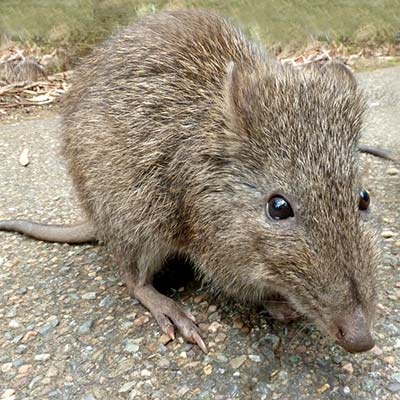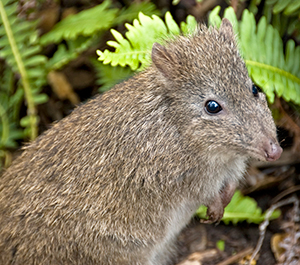Bandicoot: The Ultimate Guide

Contents
Bandicoot Description
The bandicoot is a small to medium-sized omnivorous nocturnal marsupial with a long, pointed snout, humped back, large hind feet, and thin tail. It has short and stiff grey, brown, black, or golden fur, with a lighter coloured underbelly. Its forelegs are much shorter than its hind legs which have elongated feet similar to a kangaroo. Bandicoots range in size from 28 to 81 cm in length and weigh between 0.2 to 1.6 kg. Males are larger than females.
The bandicoot is often mistaken for a rodent, but it’s actually a unique species of marsupial. There are about 20 species of bandicoots in Australia. The three main types of bandicoots in Australia are the: Long-nosed Bandicoot, Northern Brown Bandicoot and Southern Brown Bandicoot. The bandicoot's scientific name is Peramelemorphia.
How a Bandicoot Moves

Photo: Bandicoot posing
While the bandicoot, with its large rear feet, may seem like a hopping marsupial, it actually moves using a slow bunny hop, with the front and back legs working alternately. When moving fast, they bound and gallop. They can also jump vertically to heights of nearly 2 m when chased or alarmed. The only time a bandicoot hops on its two hind legs, with its body held near-vertical, is when it is posturing in a conflict situation. Bandicoots are terrestrial, they don't climb trees.
Fun Bandicoot Fact
The name "bandicoot" is derived from the Indian name "pandi kokku", which translates to "pig-rat". It is not certain how the Indian name got transferred to an Australian marsupial, but Australian bandicoots do look somewhat similar in appearance to the Indian rat. The first known use of the word was by the explorer George Bass in 1799.
Bandicoot Sounds
Bandicoots are one of the more vocal marsupials, producing at least four distinct sounds:
- When annoyed, they make a "whuff, whuff" sound.
- When frightened or in pain, they let out a loud shriek.
- They use a high-pitched sound to locate each other.
- They make a snuffing sound when looking for food, followed by a grunting sound when food is found.
Bandicoot Adaptations
Bandicoots have several adaptations that make them suitable for the harsh and arid Australian environment.
• Nocturnal Behaviour - Bandicoots are active during the night and sleep in their nest during the day. This keeps them out of the hot Australian sun.
• Rear-facing Pouch Opening - Prevents dirt from entering the female’s pouch when she is digging.
• Strong Digging Claws - For digging out underground prey.
• Long Pointy Nose - To sniff out its prey.
• Long Pointed Teeth - Allows it to grab and chomp through its food.
Bandicoot Habitat
Bandicoots live shrubland, woodland and rainforests throughout Australia. They prefer open areas to forage for food at night and dense vegetation in which to shelter during the day. Since European settlement, the bandicoots' range has been dramatically reduced.
Bandicoots are solitary, territorial animals. The female's home range is 1-4 ha and 18-40 ha for a male. They mark their territory with scent from a gland behind their ears and will aggressively defend their territories. They do this by standing on their hind legs and ferociously clawing at each other's shoulders and backs until one withdraws defeated. Bandicoots forage in open areas during the night and rest in nests during the day.
Bandicoots built their nests on the ground in dense shrub. They line their nests with dry grass pulled and woven together and leaf litter. During the day, they sleep in these nests. They also use abandoned burrows, tunnels and logs.
What do a Bandicoots Eat?
Photo: Bandicoot foraging for food
Photo: Bandicoot foraging hole
A Bandicoot's diet consists of insects, spiders, beetles, earthworms, centipedes, millipedes, and insect larvae. They also eat roots, seeds, fallen fruit, plant tubers, and fungi. Bandicoots drink by lapping water like a cat. Some desert species require very little water and get all the moisture they need from their food.
Bandicoots forage at night using their sensitive noses to sniff out food. When bandicoots detect food underground, they dig a conical hole with their strong flattened fore-claws and reach their meal with their long snouts. They hold their food in their front paws while eating.
Bandicoot Reproduction & Life Cycle
Bandicoots only gather together for mating. This is the only time a female will tolerate male company. A female bandicoot can have a new litter every 7 to 8 weeks but usually has 2 to 3 litters a year. Bandicoots have the shortest gestation period of any marsupial, lasting just 12 days. Females can give birth to as many as five babies. The young are born tiny and underdeveloped and travel through a cord attached to the mother's womb to reach her pouch. Once in her pouch, each attaches itself to a teat and remains in her backwards-facing pouch for another two months. Young bandicoots become independent at about four months and are sexually mature at about five months.
Bandicoots live for between 2 to 5 years.
Bandicoot Threats and Predators
Photo: Bandicoot road sign
Photo: Fox with a killed bandicoot
Bandicoots fall prey to foxes, dingoes, quolls, large birds, feral and domestic cats, and dogs. They are also impacted by competition with rabbits for food and nesting areas.
Climate change, bush fires and habitat loss also have a significant impact on their decline.
Many are killed by motor vehicles and even snail bait poisoning.
Is the Bandicoot Endangered?
Seven species of bandicoots in Australia, are critically endangered or already extinct. Bandicoots are protected in all states of Australia. It is illegal to trap or kill them. Some states allow captive-born bandicoots to be kept as pets. However, they are not particularly suitable as pets.
Types of Bandicoot
There are three types of bandicoot in Australia.
Long-nosed Bandicoot
Photo: Long-nosed Bandicoot
Photo: Long-nosed Bandicoot Habitat Map
The Long-nosed bandicoot has bristly and rough grey-brown fur, a pointy nose and pointy ears. It has a hunched posture, a short tail and its front feet have three long-nailed toes each. About the size of a rabbit, this marsupial is between 31-43cm in length and weighs up to 1.5kg.
The long-nosed bandicoot lives in rainforests, gullies and grassy woodlands along the eastern coast of Australia from the Cape York Peninsula in North Queensland to Victoria. (Red area on map).
Northern Brown Bandicoot
Photo: Northern Brown Bandicoot
Photo: Northern Brown Bandicoot Habitat Map
The northern brown bandicoot has thick rough speckled brown-black fur, a pointy nose, and small rounded ears. It is between 30-47cm in length and weighs up to 2.0kg.
The northern brown bandicoot is found in the northern parts of Australia and down the eastern coast to central New South Wales. (Purple area on map).
Southern Brown Bandicoot
Photo: Southern Brown Bandicoot
Photo: Southern Brown Bandicoot Habitat Map
The southern brown bandicoot has dark grey yellowish-brown fur, a long conical nose, and small rounded ears. It has a hunched posture, a short tail and its front feet have three long-nailed toes each. About the size of a rabbit, this marsupial is between 28-36cm in length and weighs up to 1.5kg.
The southern brown is only found small pockets in Victoria and South Australia. (Green area on map).
25 Fascinating Bandicoot Facts
- Bandicoots are rat-like marsupials.
- They have long pointed snouts, humped bodies, short front limbs, large hind feet and thin tails.
- Bandicoots are 28–81cm in length and weigh between 0.2–1.6kg.
- They are very similar in appearance to rats. But the bandicoot is a marsupial, not a rodent.
- The name bandicoot is derived from an Indian name for a rat - 'pandi kokku'.
- The male can be up to twice as large as the female.
- Bandicoots are found throughout Australia.
- They are solitary animals.
- The male has a home range of 18-40 ha, and the female has a smalls range of 1-4ha.
- A bandicoot will aggressively defend its home range from other bandicoots.
- They fight by standing on their hind legs and ferociously clawing at each other.
- Bandicoots are more vocal than most other marsupials.
- They whuff, shriek and grunt.
- Bandicoots move using a slow bunny hop.
- Even though it is tiny, it can leap 2m i to the air when frightened.
- The bandicoot's pouch faces backwards to prevent dirt from entering it while digging.
- They are nocturnal, coming out only when it's dark.
- Bandicoots are opportunistic omnivores feeders. They eat both animal and plant matter.
- Their long pointed snouts help them sniff out their prey underground.
- They have small, sharp, even-sized teeth well suited to an insectivorous diet.
- They drink by lapping water like a cat.
- There are about 20 species of bandicoots in Australia.
- Seven species of bandicoot are critically endangered or already extinct.
- A female can have a new litter every 7 to 8 weeks but usually has 2 to 3 a year.
- Bandicoots have a lifespan of 2 to 5 years.